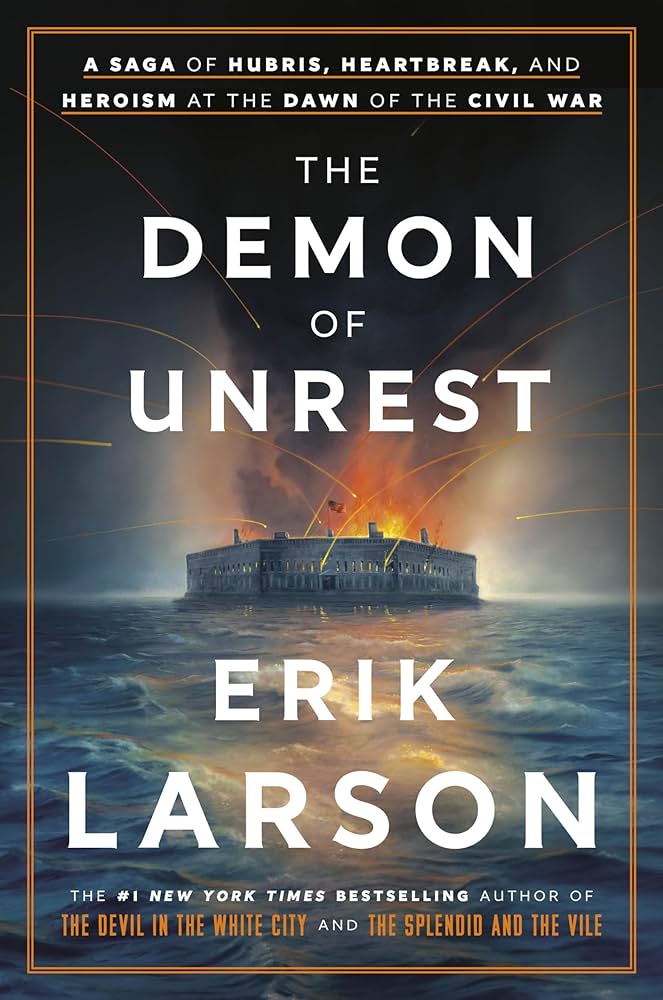Like so many of us, Erik Larson could have picked up a sourdough starter or learned to crochet during the pandemic. But the best-selling narrative history author, whose books include The Devil in the White City and The Splendid and the Vile, decided to spend his Covid years immersed in the deadliest war in American history, learning everything he could about the pivotal five months leading up to the Civil War.

“I had just finished my tour on my last book about Winston Churchill. I took a plane home and the world shut down,” Larson says. “It was a time of pretty intense political discord, as you’ll recall, and people were saying, ‘Oh, there’s going to be a second Civil War.’ That got me thinking, how exactly did the Civil War start?”

On April 30, readers can find out with the release of The Demon of Unrest: A Saga of Hubris, Heartbreak, and Heroism at the Dawn of the Civil War, Larson’s doggedly researched, detailed account of 1861 Charleston, South Carolina, on the cusp of secession. To gain insight into this distinctive era and the author’s meticulous probing process, G&G recently connected with Larson via Zoom.
G&G: The first thing I thought when I started reading Demon of Unrest was the famous Robert Caro adage “turn every page,” a reminder to journalists to read every document, dig deeper, and go further in their investigations. You’ve certainly done that here.
EL: Thank you. The Civil War has been written about so much, [and] there are a lot of online archives that were actually quite good. But I came across this collection of documents, The War of the Rebellion: a Compilation of the Official Records of the Union and Confederate Armies. I just started reading through it and ordered a hard copy of volume one—which, of course, I disinfected first. I was absolutely captivated because in this book, there were hundreds of documents arranged in scrupulous chronological order that really captured the tension, suspense, and inexorable descent toward civil war. You had a telegram, then a response. A letter and its response—reports, responses—all in this march toward war. I thought, “Wow, this doesn’t happen that often when you’re a writer, when somebody just lays it all out for you.”
G&G: Right, but of course none of this is new. Full disclosure, I’m married to a high school history teacher, and the love of his life—besides me—is studying the Civil War. So my home is like an emporium of Civil War history books. And I’ve watched Ken Burns’s The Civil War about a thousand times
EL: Oh, I just did Ken Burns’s podcast.
G&G: Nice! In our house we refer to him as Kenny B.
EL: He’s a great guy.
G&G: And he’s a great example of how much exists already on this topic. There are Ken Burns documentaries, the books 1861 and Allegiance. How did you approach this, knowing you were a newbie to a well-researched topic? Let me add, I found your book fascinating because these are all new details to me. But how do you approach something like that?
EL: You and my wife are my perfect audience—people who have zero interest in reading about the Civil War.
I wouldn’t have started the project if I didn’t feel there was something I could bring to the party. What I bring is all in the telling. There’s a certain orthodoxy to Civil War scholarship. My goal is to sort of step outside that orthodoxy and tell the story as a newcomer—that’s my superpower, that’s my advantage.
G&G: Your eye for detail, for characters, and especially for unique anecdotes is what really sucked me in. For instance, Edmund Ruffin, the very pro-slavery Virginia planter and Southern firebrand, plays a big role in your book.
EL: Isn’t he a great villain? Ruffin has been written about sort of in passing in many books. But I wanted to make him step forward. He lived such a tragic life, his daughters die, he didn’t like his son Charles, and his ending!
G&G: Oh my gosh, yes. No spoilers, but it’s pretty horrible. This book is filled with side stories like that, like Ruffin’s or Mary Boykin Chesnut, the wealthy Charlestonian who kept a diary throughout the entire conflict and whom many readers will recognize thanks to Ken Burns.
EL: I wanted Chesnut to be a flesh-and-blood human being moving through. There is absolutely no reason anyone writing about the Civil War should have included her flirtations with another man, but I found it fascinating.
G&G: And it makes this time period more authentic.
EL: My attitude about my books is that there’s the central narrative, but I treat it as kind of like a Christmas tree. I get to hang those little fancy ornaments on it. And those are the things that I live for. Just little details that might bring a story absolutely alive.
G&G: To your point, one of those details is the amount of chewing tobacco that’s found on every surface in America. As a character in your book, the British journalist Sir William Howard Russell, observes in his first days in Charleston: “The tumult, the miscellaneous nature of the company, the heated, muggy rooms, not to speak of the great abominableness of the passages and halls, despite a most liberal provision of spitoons, conduce to render these institutions by no means agreeable to the European.”
EL: Wasn’t that crazy? His diary is constantly talking about that. I don’t think there’s anything about chewing tobacco in Ken Burns’s documentaries.
The Demon of Unrest comes out April 30, 2024. Charleston Gaillard Center and Buxton Books present A Conversation with Erik Larson on Thursday, May 16, at the Gaillard at 95 Calhoun Street. Find out about more stops on his national book tour here.








